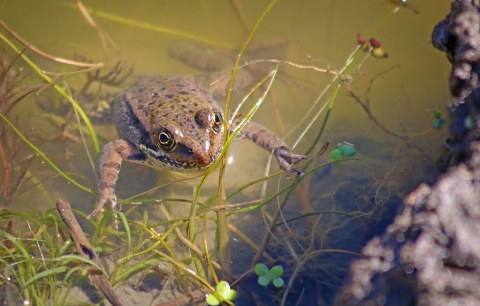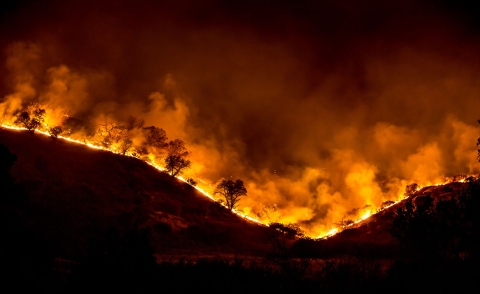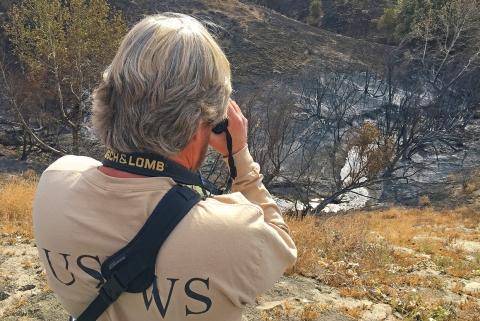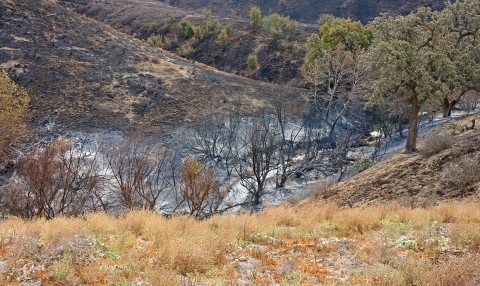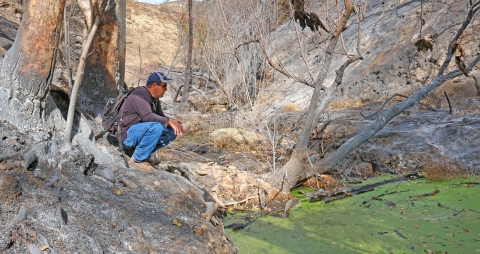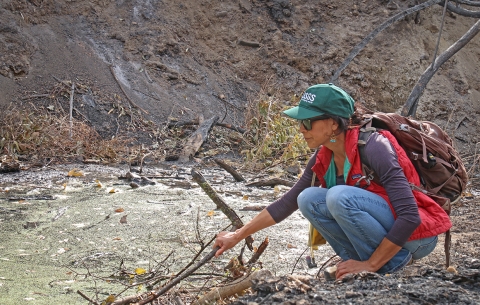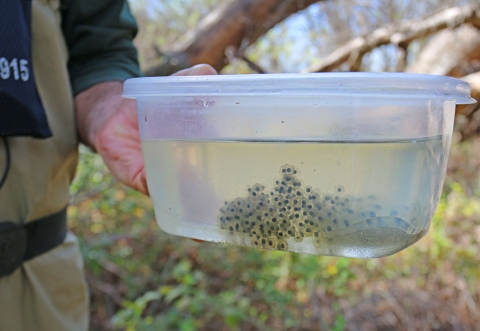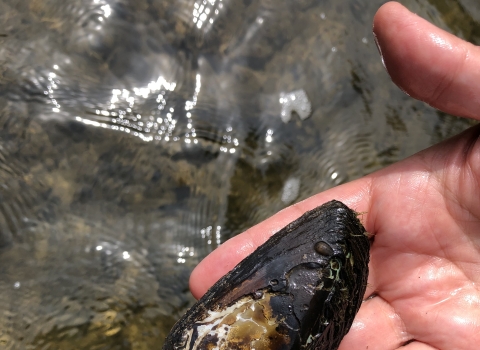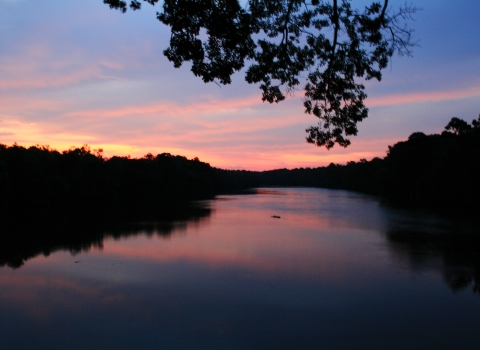By Ashley McConnell
Amid an ashy creek bed in the Simi Hills, rare frogs are fighting for survival following the Woolsey Fire, which swept across Ventura and Los Angeles Counties this November, prompting mass evacuations. While thousands of residents fled their homes, California red-legged frogs, a threatened species, hunkered down in creek bottoms, and waited.
Fueled by persistent Santa Ana winds, the Woolsey Fire burned nearly 100,000 acres, destroying more than 1,500 homes, businesses, and other structures from inland Thousand Oaks to the seaside town of Malibu. Nearly half of the Santa Monica Mountains burned, including sites where California red-legged frogs were reintroduced in recent years to help boost the dwindling population.
When it was safe for residents to return home in the days following the fire, a team of scientists huddled around a creek bed surrounded by darkened hillsides. Emergency response helicopters flew overhead.
“There’s one there. It’s alive,” said Chris Dellith, senior wildlife biologist with the U.S. Fish and Wildlife Service. An adult California red-legged frog hopped from a tumbled tree branch into the water and disappeared.
Dellith and partners from federal and state agencies came together to assess damage areas where the threatened species is known to exist, including a site in the Simi Hills where for the past four years, scientists have collected frog eggs to transplant to new areas in the Santa Monica Mountains to aid in the recovery of the species. All four sites were impacted by the fire.
While driving southbound on Highway 101 en route to the survey site, Dellith looks at the charred landscape and reminisces about a childhood spent playing in those very hills. “These are my old stomping grounds.” When asked how many fires he’s been through since he moved to California in 1971, he said, “I’ve lost count.”
We rolled down the windows as we entered the town of Calabasas; the air is thick with the smell of a summer campfire.
It will be at least a year until scientists are able to determine the fire’s effects to the California red-legged frog population in the Simi Hills, and now, a new challenge for the rare amphibians - winter rains.
“The rains are a mixed blessing,” Dellith said. An hour-long deluge could send earth loosened by the fire into the stream bed, bringing with it toxic ash that could kill the frogs and leave their breeding habitat without clean water to mate and lay their eggs during the spring breeding season.
A consistent drizzle over a day, on the other hand, could have the opposite effect, providing just enough water to germinate the unburned seedbank, which in turn would grow roots and anchor the soil on the adjacent slopes in place.
Tim Hovey, senior environmental scientist with California Department of Fish and Wildlife, has monitored California red-legged frog populations in the area for the last 15 years.
“It’s terrible that this happened, but I’m encouraged by what I see,” Hovey said as he looked up at the blackened hillsides scattered with oak trees. “The sloping hillsides around this creek bed are not very steep, so we may not see a tremendous amount of sediment flowing down. We’ll see what happens after the rains.”
Hovey and the other scientists have a strategy to intervene following winter rains if needed.
Following the Copper Fire in 2002 which impacted portions of the San Francisquito Canyon in Los Angeles County, “we created artificial pools alongside the existing stream channel that had been closed in by the sediment from heavy rains,” said Elizabeth Gallegos, biologist with the U.S. Geological Survey. “The frogs successfully bred in those pools until the habitat reestablished itself.”
Years later, Gallegos said, “the frogs in that area are doing great.”
The frogs in the Simi Hills have also been doing well in recent years, Gallegos said. She and others have been surveying the frog population there since 2009. In 2017, she documented 76 egg masses in just a 250 meter reach of the creek bed.
There were enough frogs in the Simi Hills to support a reintroduction program that began in 2014, when scientists moved the first egg masses from the Simi Hills into a site in the Santa Monica Mountains National Recreation Area.
Since then, egg masses from the Simi Hills have been transplanted year after year, in the hopes that eggs would metamorphose into tadpoles and ultimately adult frogs that would then reproduce on their own. In 2017 and 2018, scientists rejoiced when frogs were documented reproducing at two of the introduction sites – a sign of the program’s remarkable success.
“We’re concerned about the introduction sites, but we’re certainly not going to give up,” said Seth Riley, wildlife ecologist with the Santa Monica Mountains NRA.
Riley and the rest of the team plan to keep a close eye on the frogs in the Simi Hills and survey the introduction sites in the coming weeks. They’ll conduct nighttime surveys before and after winter rains to assess habitat impacts and collect data.
While the future of the reintroduction program remains uncertain following the fire, Riley said that the team “would not put frogs into unsuitable habitat.”
“It will take a while for the habitat to recover, but it will recover,” Hovey said. “Even now, we see little sprouts of green coming up. The vegetation will return.”
While wildfires remain a threat to the long-term sustainability of the California-red legged frog population in California, Hovey, Dellith and others remain optimistic.
“There’s still hope for this species. All is not lost,” Dellith said. “It’s just going to take time.”
While California red-legged frogs range from extreme northern portions of Baja California, Mexico to northern California, they exist in only a few watersheds in Southern California. They have been lost from 70 percent of their historical range due to habitat loss and competition for resources with non-native species, like the bullfrog.
The California red-legged frog was listed as threatened under the Endangered Species Act in 1996. Since listing, the U.S. Fish and Wildlife Service has worked alongside the U.S. Geological Survey, National Park Service, California Department of Fish and Wildlife, California State Parks, Santa Monica Mountains Conservancy, Mountains Recreation and Conservation Authority, and others to support the species’ recovery.

